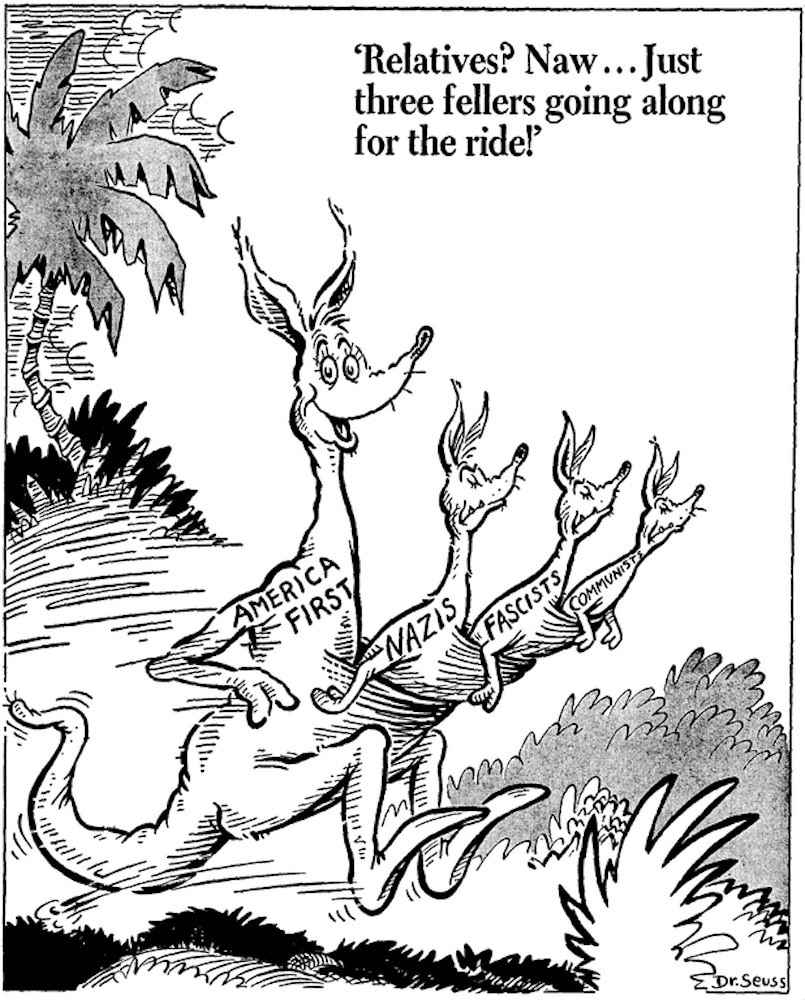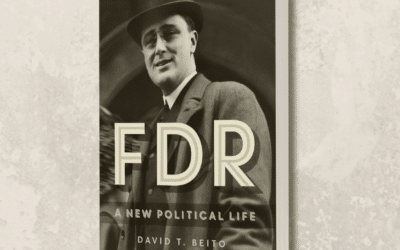The demands of the American empire have been used throughout the twentieth century to influence domestic politics and popular opinion on foreign affairs. The exaggerated threat of foreign agents and alien ideologies in league with one’s political opponents has long been used to constrain the Overton Window on foreign policy, and its one of the few bipartisan institutions in Washington. Offenders from across the political spectrum have participated in a “scare cycle” that has hampered our politics and narrowed our minds.
Such is the case today, with supporters of the foreign policy status quo routinely leveling accusations of disloyalty and duplicity upon those who advocate for a negotiated end to the Russian-Ukrainian war. As in the past, these attacks obscure the deeper roots of discontent and longer histories of antiwar activism in America. Their continued use threatens to hamper the reassessment of current foreign policy and the formulation of new approaches beyond this crisis.
The current cycle of accusation and attack arguably began during the interwar period with a phenomenon historian Leo P. Ribuffo called the Brown Scare. The Brown Scare was a moral panic over domestic right-wing extremism that conflated disparate domestic political groups with the threat of overseas fascism. At home, New Deal liberals in the press and politics conflated odious groups like the Silver Shirts or the American Bund with more mainstream conservative organizations like the America First Committee (AFC), which sought to prevent an active American entry into the Second World War.
Supporters of American intervention used the Brown Scare to discipline those voices who sought to stay out of the wars raging in Europe and the Pacific. Theodor Seuss Geisel (aka, Dr. Suess) referred to the America First Committee as a “Nazi Transmission Belt.” Investigative journalist and activist John Roy Carlson charged that American fascists were so thoroughly intertwined with the America First Committee that the two groups were almost indistinguishable. Even President Franklin Delano Roosevelt exaggerated the Nazi threat upon the Western Hemisphere and compared American noninterventionists to the “copperheads,” conservative northern Democrats who desired to make peace with the Confederacy during the American Civil War.
While it is undoubtedly true that antisemitic discourses existed within the AFC, as with the often invoked examples of Charles Lindbergh’s Des Moines speech and Senator Gerald Nye’s Hollywood hearings, it would be dishonest to characterize the entirety of the noninterventionist movement by them or their ideas. The AFC publicly disavowed endorsements from odious figures like Father Coughlin and declared that their organization “has no truck with totalitarians of any kind – nazis, fascists, communists” and that they were “opposed to them and opposed to Americans who will not defend democracy.”
Most noninterventionists were driven by memories of American involvement in previous foreign wars. Chief among them was America’s entry into World War I. The Great War’s overseas horrors, domestic civil rights abuses, revelations of British propaganda, and war profiteering led most Americans to want to refrain from embarking on another overseas adventure. Older members of the AFC, like Oswald Garrison Villard and John T. Flynn, drew their noninterventionism back to the brutal American pacification of the Philippines. And throughout the ranks of the noninterventionist movement, members believed that deeper American involvement in another European war would fundamentally change their society and the American political economy for the worse. These motivations to stay out of the war were buried by interventionists’ salacious accusations of disloyalty and cynical focus on the darker elements of the noninterventionist movement.
Charges of disloyalty coupled with the myopic fixation on antisemitism within the AFC have buried the longer histories of American antimilitarism and nonintervention. Long gone are the public memories of the horrors of the American occupation of the Philippines, U.S. government machinations throughout Latin America, and the catastrophe of World War I. The Brown Scare succeeded in associating “isolationism” exclusively with the forces of reaction, bigotry, and appeasement. This conflation and obfuscation have aided supporters of the foreign policy status quo in impeding foreign policy discourse since 1941.
The Brown Scare not only hemmed in right-wing opposition to nonintervention but also boomeranged upon the Left and further damaged American foreign policy discourse. The Second Red Scare was partially engineered by the political survivors of the preceding Brown Scare. Such plotters included AFC alums retired General Robert E. Wood and journalist John T Flynn. Wood and Flynn desired revenge for what they viewed as a smear campaign against them and the AFC engineered by the interventionist and pro-New Deal organization, the Friends of Democracy. Wood and Flynn conspired with Senator Karl Mundt (R-SD) and Representative Martin Dies (D-TX) to turn the organs of the Brown Scare against their former accusers.
Representative Dies enthusiastically agreed to turn the now-standing House Un-American Activities Committee (HUAC) into a tool for this counter-crusade. Whereas the previous select committee was concerned with far-right groups like the American Bund and Silver Shirts, as well as the American Communist Party, the standing iteration of HUAC would focus on the American Left. And thus, the Second Red Scare was born.
Colloquially known as “McCarthyism,” eponymously named for the Republican Senator of Wisconsin, Joseph McCarthy, the scare had significant ramifications on domestic politics and American foreign policy debate. Fueled by the deepening Cold War and the presence of Soviet agents within the U.S. government, the Second Red Scare narrowed the left side of the political spectrum. McCarthyites used the power of the congressional subpoena and redirected elements of domestic security policy born during the Brown Scare to target their political opponents.
The winnowing of American politics contracted the Left and purged many progressives who opposed vital aspects of the nascent national security state. As with figures in the largely conservative AFC, many progressives opposed the early Cold War state due to their memories of World War I and the excesses of its prosecution. Left-wing antimilitarists also emphasized the corporate nature of American foreign policy, arguing that American militarism benefited the few at the expense of the “common man.”
The Second Red Scare would mute such voices. Among the political fatalities of McCarthyism were members of the American Labor Party, Representatives Vito Marcantonio (NY-18) and Leo Isacson (NY-24), who opposed postwar conscription, the Marshall Plan, and the Truman Doctrine. Both were unseated by electoral defeats heavily informed by the fear of domestic communism. The scare boomerang also cut the ties between the antiwar Left and the noninterventionist Right, increasing the social costs of continued collaboration.
As with the Brown Scare, the Second Red Scare disciplined future foreign policy debate, but this time on the Left. The McCarthy era incentivized Democratic aspirants to high office to take a harder line on the Soviet Union. This motivation, coupled with the Democrats’ desire for political payback, solidified the culture of liberal hawkishness within the party and helped to set the stage for the deepening of American commitment in Vietnam.
The scare boomerang narrowed the range of acceptable foreign policy opinion in the United States. Individual dissent remained outside government and within shrinking pockets of Congress, but the political power for restraint waned throughout the early Cold War. The so-called, and often nostalgically remembered, “vital center” was not the creation of an authoritative and reasoned unanimity. Instead, this “consensus” resulted from fundamentally illiberal political processes designed to control dissent.
Since 2001, political actors from both parties have used scare tactics in their foreign policy rhetoric. The Global War on Terror (GWOT) incentivized politicians and their mouthpieces in the corporate press to use external threats to discipline their political opponents. During the height of the GWOT, to advance their respective domestic agendas, Republicans and Democrats leveled the accusation that the other party aided and abetted terrorism. And, as with past scares, these charges hampered criticisms of U.S. foreign policy, lest one be accused of being “soft on terrorism” or opposed to “spreading democracy.”
The increase of hostilities between the West and Russia, exacerbated by Putin’s invasion of Ukraine, initiated another wave of domestic panic. Supporters of the foreign policy status quo in elected office, media, think tanks, and among the Twitterati have liberally heaped scorn upon those who do not tow the consensus line. These hawks, backed by years of Russiagate build-up, have normalized the idea that those seeking peace, de-escalation, or negotiation are, at best, apologists or worse, conscious Russian agents.
As with previous scares, interventionists are using the immediacy of the crisis to mask more extensive histories of foreign policy dissent. Interventionists often accuse those who point to a long history of hostile Western-Russian relations visa vie NATO expansion of repeating “Putin’s talking points.” In the myopia of the moment, interventionists ignore that such “talking points” circulated within national security circles for decades, were previously espoused by President Obama, and debated in Congress long before the ascent of Vladimir Putin.
Similarly, interventionists have used this crisis to deflect domestic criticisms of American institutions. Rather than own up to decades of failed policies, interventionists have shifted blame to “Russian disinformation” as the cause of American discontent. As in the past, interventionists cast dissenters not merely as earnest Americans tired of war and empire but as enemies within.
American society is dangerously close to repeating the mistakes of the past. As with the Brown and Red scares, the obscurantist rhetoric of “democracies vs. autocracies” is being used to shape domestic politics and narrow American attitudes on foreign policy. As in the past, interventionists are recasting legitimate criticisms of America’s role in the world as dangerous and alien ideologies in need of suppression. Tragically, if the past is any guide, the United States government will continue its interventionist policies if these efforts succeed.
If Americans of good conscience are to achieve a saner, more restrained foreign policy, they must resist these efforts and educate open minds about their histories and consequences.
































